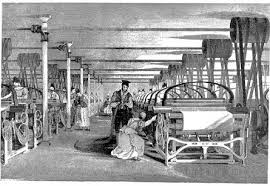“Causation in the Age of Industrialization” – Everything You Need to Know
The Industrial Revolution not only transformed economies and societies but also sparked debates on the causes behind these profound changes. How did technology, social dynamics, and political shifts interact to create a new world? In this comprehensive guide on Causation in the Age of Industrialization, we explore the factors that led to—and shaped—the industrial age. Whether you’re a history buff, a student, or simply curious about how cause-and-effect shaped our modern world, this post will break down the multifaceted forces behind one of the most transformative periods in human history.
Introduction: Unraveling the Threads of Change
Imagine a world where a series of seemingly disconnected events—from the invention of the steam engine to rapid urbanization—intertwine to reshape society. Did you know that the ripple effects of innovations during the Industrial Revolution still influence our economic and social landscapes today? In this article on Causation in the Age of Industrialization, we will:
- Provide a clear definition of causation within the context of industrialization.
- Explore the historical milestones and contextual background that set the stage for the industrial age.
- Break down key factors—technological, economic, social, and political—that contributed to this epoch.
- Illustrate real-world examples and case studies demonstrating how these causes interacted.
- Discuss the significance and modern relevance of understanding these causal relationships.
- Address common misconceptions and frequently asked questions.
- Examine current trends and debates that continue to shape our interpretation of the Industrial Revolution.
Understanding Causation in the Age of Industrialization is crucial because it enables us to grasp not only how the world was transformed but also how these insights can inform present-day decision-making and policy formulation.
What Is “Causation in the Age of Industrialization”?
Defining the Concept
Causation in the Age of Industrialization refers to the complex interplay of factors that brought about the dramatic changes during the Industrial Revolution. This concept examines the cause-and-effect relationships among technological innovations, economic transformations, social upheavals, and political reforms that collectively redefined societies in the 18th and 19th centuries.
Key Characteristics:
Interconnected Factors:
Multiple causes—including scientific breakthroughs, new production methods, demographic shifts, and political ideologies—worked together to drive industrial change.Technological Innovation:
Inventions like the steam engine, power looms, and mechanized manufacturing were not isolated events; they triggered broader economic and social shifts.Economic Dynamics:
The transition from agrarian economies to industrial ones led to increased production, global trade expansion, and the rise of capitalist markets, each reinforcing the other.Social Transformation:
Urbanization, the emergence of a new working class, and shifts in family structures illustrate how industrialization reshaped social relations.Political and Ideological Change:
The need to regulate new economic realities and manage social unrest spurred reforms and ideologies that reimagined governance and individual rights.
By exploring these elements, we can better understand how causation—both direct and indirect—shaped the Industrial Revolution and continues to inform our understanding of historical change.
Historical and Contextual Background
Setting the Stage for Industrial Change
The Industrial Revolution did not occur in isolation; it emerged from a confluence of historical conditions that set the stage for rapid transformation.
Pre-Industrial Society
Before industrialization, societies were predominantly agrarian, with economies based on manual labor and small-scale production. Social hierarchies were deeply entrenched, and technological innovation was relatively slow. However, several key developments laid the groundwork for change:
Agricultural Revolution:
Innovations in farming techniques increased food production, which in turn supported larger populations and freed up labor for industrial work.Enlightenment Thought:
Intellectual movements that emphasized reason, progress, and scientific inquiry spurred curiosity and innovation, challenging traditional authority and opening minds to new possibilities.Colonial Expansion and Global Trade:
The accumulation of wealth through colonial ventures and trade provided the capital necessary for investment in new technologies and industries.
Milestones in the Industrial Era
Several landmark events and developments catalyzed the shift from traditional economies to industrial powerhouses:
- The Invention of the Steam Engine:
- James Watt’s Breakthrough: The improvements made to the steam engine in the late 18th century revolutionized transportation and manufacturing. This invention is often cited as a primary cause of industrial growth.
- The Rise of Factories:
- Centralized Production: The emergence of factory systems enabled mass production, dramatically increasing efficiency and output. This shift transformed labor practices and urban landscapes.
- Transportation and Communication Advances:
- Railroads and Telegraphs: These innovations connected distant regions, facilitating the exchange of goods, ideas, and capital. They played a pivotal role in knitting together the fabric of industrial society.
- Capital Accumulation and Investment:
- Financial Innovations: The development of banking, stock markets, and other financial instruments provided the necessary capital to fund industrial enterprises and large-scale infrastructure projects.
Notable Anecdotes
The “Iron Bridge” of Shropshire:
Constructed in 1779, the world’s first iron bridge symbolizes the technological and material breakthroughs that characterized the age.Urban Growth in Manchester:
Manchester became known as “Cottonopolis” due to its rapid growth and industrial might, illustrating the profound social and economic changes driven by industrialization.
In-Depth Exploration / Main Body
To fully grasp Causation in the Age of Industrialization, we need to dissect the multiple factors that played pivotal roles during this transformative period. The following sections break down these factors into clear, manageable components.
1. Technological Innovations: The Engine of Change
a. The Steam Engine and Mechanization
The Steam Engine’s Impact:
The steam engine powered not only factories but also transportation, enabling faster movement of goods and people. James Watt’s improvements transformed energy use and production processes.Mechanization of Textiles:
Innovations like the spinning jenny and power loom revolutionized the textile industry, leading to mass production and a dramatic increase in output.Ripple Effects:
These technological advances sparked further innovation, creating a cycle where new technologies led to increased production and subsequent demand for additional improvements.
b. The Role of the Machine Age
Automation and Assembly Lines:
The introduction of assembly line production, particularly in the late 19th century, increased efficiency and reduced costs. This method later became a model for modern manufacturing.Precision Engineering:
Advances in metallurgy and machinery design improved product quality and durability, laying the groundwork for industries ranging from construction to transportation.
2. Economic Dynamics: The Rise of Capitalism and Market Economies
a. Shifts from Agrarian to Industrial Economies
Transformation of Labor:
As industrial factories replaced traditional workshops, labor shifted from artisanal production to specialized, repetitive tasks. This change redefined work and created new economic classes.Capital Accumulation:
The need for investment in machinery and infrastructure led to the rise of capitalist economies, where private investment fueled industrial expansion.Market Expansion:
Industrialization not only increased production but also expanded markets. Global trade flourished as countries exported manufactured goods, reinforcing economic growth.
b. The Role of Financial Institutions
Banking and Investment:
The evolution of modern banking systems and financial markets enabled the mobilization of large sums of capital. Investment in railroads, factories, and other infrastructure projects became possible, accelerating economic development.Government Intervention:
In some cases, governments enacted policies to stabilize markets and encourage industrial growth. These interventions included tariffs, subsidies, and the establishment of central banks.
3. Social Transformation: Urbanization and Shifts in Society
a. Urbanization and Demographic Changes
Mass Migration:
The promise of factory jobs led to a massive migration from rural areas to urban centers. Cities like London, Manchester, and New York expanded rapidly, becoming hubs of economic and social activity.Challenges of Urban Life:
Rapid urbanization brought issues such as overcrowding, inadequate sanitation, and public health crises. These challenges, in turn, spurred reforms and innovations in urban planning and public services.New Social Classes:
Industrialization gave rise to new social strata, including a burgeoning middle class and a distinct working class. This shift reshaped family structures, social mobility, and cultural norms.
b. Labor and Class Conflict
Exploitation and Struggle:
The harsh conditions of factory work led to labor unrest and the formation of trade unions. Workers began to demand better wages, shorter hours, and safer conditions.Social Reforms:
The struggles of the working class prompted a series of social reforms aimed at mitigating exploitation and improving quality of life. These included labor laws, public health initiatives, and educational reforms.
4. Political and Ideological Shifts: Reforming Governance and Society
a. The Evolution of Political Institutions
From Absolutism to Constitutionalism:
The dramatic changes of the Industrial Revolution contributed to the decline of absolute monarchies and the rise of constitutional and representative governments.Legislative Reforms:
Governments introduced reforms to regulate labor, finance, and public welfare. These policies not only addressed the immediate challenges of industrialization but also laid the foundation for modern social welfare states.
b. Ideological Responses and Reform Movements
Liberalism and Democracy:
Enlightenment ideals of individual rights and representative government found new expression in the reform movements of the 19th century. These ideologies promoted political change as a means to achieve economic and social progress.Socialism and Labor Movements:
In response to the inequities of capitalism, socialist ideologies gained traction. Figures like Karl Marx provided theoretical frameworks that inspired labor movements and influenced public policy.Conservatism and Stability:
While reformers pushed for change, conservative forces sought to preserve established traditions and social order. This tension between progress and stability defined much of the political discourse during the era.
Importance, Applications, and Benefits
Understanding Causation in the Age of Industrialization offers valuable insights that extend far beyond the historical period itself. Here’s why this understanding is critical:
a. Informing Modern Economic and Social Policy
Policy Lessons:
The causes behind industrial transformation provide critical lessons for modern policymakers. By examining what worked—and what didn’t—governments can design better policies to address current economic and social challenges.Economic Strategy:
Understanding the dynamics of capital accumulation, market expansion, and financial regulation helps contemporary economists and business leaders create more resilient and inclusive economic models.
b. Shaping Social Reforms and Urban Planning
Improving Public Infrastructure:
Lessons learned from 19th-century urban challenges continue to inform modern urban planning and public health policies. Innovations in housing, transportation, and sanitation are directly linked to historical experiences.Empowering Labor Movements:
The evolution of labor rights and trade unions provides a blueprint for contemporary social reform movements aimed at reducing inequality and ensuring fair working conditions.
c. Enhancing Educational and Cultural Understanding
Historical Literacy:
A deep understanding of causation during the Industrial Revolution enriches our cultural and intellectual heritage. It allows us to appreciate the complex interplay of forces that shape our world.Critical Thinking:
By analyzing historical causation, students and scholars learn to think critically about the relationships between technology, economy, society, and politics—skills that are invaluable in today’s interconnected world.
d. Global Implications and Future Trends
International Development:
The patterns of industrial transformation offer insights into how developing nations can navigate modern challenges. Lessons from the past can help guide sustainable development and economic modernization efforts.Anticipating Change:
In an era of rapid technological innovation and globalization, understanding historical causation helps anticipate future trends. It provides a framework for predicting how new technologies and economic shifts may impact society.
Addressing Common Misconceptions and FAQs
Despite extensive study, several misconceptions about Causation in the Age of Industrialization persist. Here are some common questions and clarifications:
FAQ 1: Was industrialization driven solely by technological innovation?
- Misconception:
Some argue that the steam engine and other inventions were the only driving forces behind the Industrial Revolution. - Reality:
While technology was crucial, it was intertwined with economic, social, and political factors. Capital investment, demographic changes, and ideological shifts all played significant roles.
FAQ 2: Are the causes of industrialization clear-cut and linear?
- Misconception:
It is often assumed that there is a simple, direct cause-and-effect relationship between technology and industrial growth. - Reality:
Causation in this era is multifaceted and complex. Multiple factors interacted in non-linear ways, creating feedback loops and reinforcing cycles that collectively transformed society.
FAQ 3: Do the lessons of industrial causation have little relevance today?
- Misconception:
Some critics believe that because industrialization happened in the past, its lessons are outdated. - Reality:
Many modern challenges—such as rapid technological change, urbanization, and economic inequality—mirror the issues of the industrial age. The historical insights remain valuable for contemporary policy-making and social planning.
FAQ 4: Is industrial causation solely a European phenomenon?
- Misconception:
There is a belief that the Industrial Revolution’s causes are only applicable to Europe. - Reality:
While Europe was the epicenter, the causal dynamics of industrialization have influenced global patterns of development. Countries worldwide continue to grapple with similar transformative forces.
Modern Relevance and Current Trends
a. Digital Transformation and Economic Change
Technological Parallels:
Just as the steam engine revolutionized the 19th century, today’s digital technologies—artificial intelligence, automation, and the internet—are reshaping economies. Understanding historical causation helps contextualize these modern shifts.Future Forecasting:
By studying how past technological innovations spurred economic transformation, policymakers and business leaders can better anticipate and manage current digital disruptions.
b. Urbanization and Social Policy
Lessons for Modern Cities:
The rapid urbanization experienced during industrialization offers valuable lessons for today’s megacities. Issues of housing, public transportation, and environmental sustainability are as relevant now as they were in the past.Innovative Solutions:
Modern urban planners draw on historical experiences to develop smart city initiatives that integrate technology, sustainability, and social equity.
c. Globalization and Economic Policy
Interconnected Economies:
The expansion of global trade during the Industrial Revolution provides a historical parallel to today’s interconnected markets. Lessons in market regulation, financial oversight, and trade policy continue to guide international economic strategies.Policy Relevance:
Understanding causation in the industrial era helps governments create policies that mitigate inequality and promote sustainable growth in an increasingly globalized world.
d. Cultural and Educational Implications
Building Historical Literacy:
As societies face rapid changes, a well-informed public that understands historical causation is better equipped to participate in civic life and advocate for informed policy decisions.Educational Innovation:
Integrating the study of historical causation into educational curricula fosters critical thinking and a deeper appreciation for the complex forces that shape our world.
Conclusion: The Enduring Impact of Causation in the Age of Industrialization
Summarizing the Key Points
Causation in the Age of Industrialization is a multifaceted concept that examines how technological, economic, social, and political factors combined to reshape the world during one of history’s most transformative periods. Key takeaways include:
- Interconnected Dynamics:
Industrialization was driven by a complex interplay of multiple causes rather than a single factor. - Historical Insights:
The lessons learned from this era inform modern policies and help us understand current challenges in technology, urban development, and economic regulation. - Modern Relevance:
Many of the issues and solutions from the Industrial Revolution continue to resonate today, offering valuable guidance for navigating contemporary transformations. - Empowerment Through Knowledge:
A deep understanding of historical causation empowers citizens, policymakers, and business leaders to make informed decisions that promote sustainable progress.
Reinforcing the Importance of Understanding Causation
Grasping Causation in the Age of Industrialization is essential not only for historians but for anyone interested in the mechanisms that drive societal change. By understanding these causes, we can better appreciate the forces that continue to shape our modern world and harness that knowledge to address current challenges.
A Call-to-Action
We invite you to:
- Explore Further:
Delve into historical texts, documentaries, and academic research on the Industrial Revolution and its causes to deepen your understanding. - Engage in Discussion:
Share your insights, questions, and reflections in the comments below or on our social media channels. How do you see the legacy of industrial causation influencing your community or industry today? - Stay Informed:
Subscribe to our newsletter for more in-depth articles on history, economic transformation, and social change. Your participation helps keep the dialogue vibrant and drives collective progress.
Additional Resources and Further Reading
For those interested in exploring Causation in the Age of Industrialization further, here are some reputable sources:
Books and Academic Journals:
- The Age of Revolution: 1789-1848 by Eric Hobsbawm
- The Condition of the Working Class in England by Friedrich Engels
- Scholarly articles in journals such as The Journal of Economic History and Modern Intellectual History.
Digital Archives and Museums:
- The Digital Public Library of America (DPLA) for primary sources on the Industrial Revolution.
- Europeana Collections, featuring digitized documents and artifacts related to industrial change.
Government and Educational Websites:
- Resources from the Library of Congress and the British Library.
- Online courses on platforms like Coursera and Khan Academy covering the Industrial Revolution and economic history.
Interactive Timelines and Documentaries:
- Multimedia timelines on History.com that illustrate key milestones.
- Documentaries available on PBS, Netflix, and YouTube that explore the causes and effects of industrialization.
Final Thoughts
The exploration of Causation in the Age of Industrialization reveals a rich tapestry of interconnected forces that transformed society in ways still evident today. From technological breakthroughs and economic shifts to social upheavals and political reforms, the causes behind industrialization offer timeless lessons on how change occurs. These insights not only deepen our understanding of the past but also equip us to navigate the challenges of our rapidly evolving world.
Thank you for joining us on this journey through one of history’s most fascinating periods. If you found this post insightful, please share it with friends, colleagues, and anyone interested in the transformative power of cause and effect in shaping our world. Let’s continue the conversation and use the lessons of the past to drive positive change for the future.







